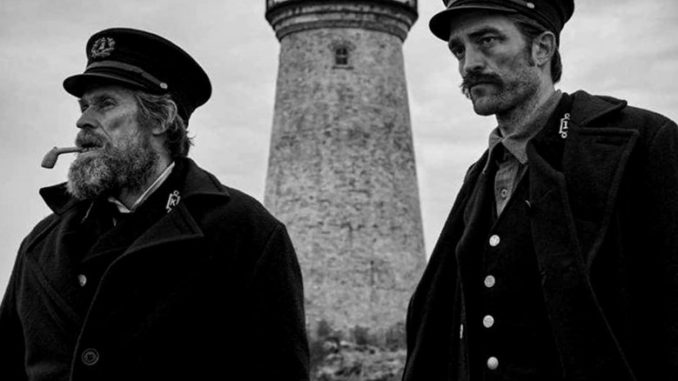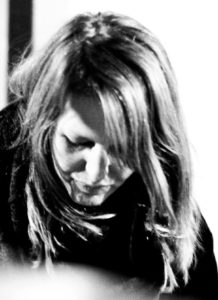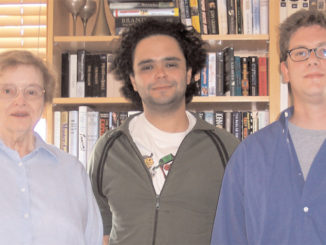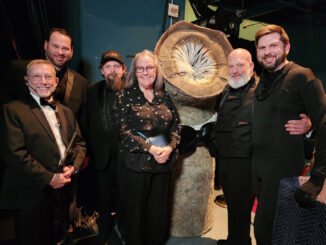
by Patrick Z. McGavin
Louise Ford didn’t start out as a film editor. She worked for years as a journalist in her native Britain.
But since then, she’s made up for lost time.
The now-Brooklyn-based editor has shown tremendous versatility and range in her work, from horror movies, like “Don’t Breathe” (2016) and literary adaptations such as Paul Dano’s “Wildlife” (2018).
Her most significant collaboration has been with the American independent filmmaker Robert Eggers. Her breakthrough credit was the director’s debut feature, the 17th century allegory, “The Witch” (2015).
Their new work, “The Lighthouse,” is an eerie, claustrophobic mood piece about a 19th-century lighthouse keeper (Willem Dafoe) and his charged, potent relationship with his protege (Robert Pattinson).
Shot in high-contrast black-and-white in the old silent-era Fox Movietone aspect ratio 1:19, the movie is visually distinctive.
In an exclusive CineMontage interview, Ford talked about the challenges and satisfactions of working in such non-traditional forms.
You are working for the second time with the writer and director, Robert Eggers. Did it feel like a natural continuation of your first film together?
Louise Ford: This is actually our fourth collaboration, because I cut two shorts before “The Witch.” This is the second feature. We are friends. I have known him for 12 years.
We are kind of on the same creative wavelength. We work very hard, we have a great laugh and we take the work very seriously, but [we do] not take ourselves very seriously. It’s a very relaxed, fun, creative environment.

The film was shot at a very remote location in Nova Scotia. Where were you during the production?
I was on location. It was the same as on “The Witch,” which was shot at a very remote part of Ontario. With “The Lighthouse,” it was shot in a very small town on the coast of Nova Scotia.
As far as the practicalities and the logistics, we are shooting on film. They shot on film, and that was processed by Fotokem in Los Angeles. It was shipped to them. They processed it and scanned it and made digital files, and then we downloaded them in Nova Scotia and worked from there.
The challenge with that was the turnaround time because it was four or five days. We had a short shooting schedule. When I knew about that, I was uncomfortable with the turnaround time. I insisted on a video temp so that we have access to that the next day. I asked my assistant to prep that as if it were the real dailies, put into takes, put into scene bins, so I could throw that together quickly.
You can’t see real focus or camera issues, but at least you can see how the scenes come together, and if there is something I need to be concerned about and that I can bring to the director’s attention.
Robert Eggers talks about how the script he co-wrote with his brother Max was inspired by the period journals of Herman Melville and other seafaring materials. Did you do specific research?
Rob does all the research. I pretty much don’t want to second-guess him by doing a bunch of my own research.
It’s inevitable when he is writing these scripts he sends them to me. He wants to know if there is something that is not clear. He really works these scripts before he starts shooting, which is brilliant.
When I start reading his script, I might go away and read stuff if there is something I might find useful. I would not deign to correct him. It’s more a question of what can you add to it, what can you bring to it. I revel in that. I never have a problem with that.
Being English, with both “The Witch” and “The Lighthouse,” the language feels very Shakespearean. Partly because it’s old fashioned, I rarely get an inkling of a word that I don’t know what it means. I was a very literature-oriented child. I did a degree in English literature.
Part of the reason why Rob and I connect is that he is a bit of an Anglophile. His father was a professor of Shakespeare and he came from a theatrical background because his mom ran a children’s theater. His first forays into drama were in the theater.
The reason why we connected in the very beginning, his script for “The Tell-Tale Heart” (2008), that was the first thing I ever edited. As soon as I read his script, I immediately knew that Rob was unusual, original, super-talented, and we just connected because we are into the same strange stuff. We had the same references, like Victorian illustrators and music. It doesn’t feel as weird to me when I am reading it.
Like “The Witch,” the movie is very distinctive visually. It was also shot in the very rare Movietone format, the 1:19 aspect ratio. As the editor, what were the particular challenges of that?
To be honest with you, creatively those things are kind of meaningless to me, in terms of how I make choices about the performance and pace. It’s storytelling. The aspect ratio or the fact it’s black and white doesn’t have any impact at all, I don’t think.
It’s more about the practical situations of the fact we had shot on film, the turnaround time, that had an impact on my editing choices. Jarin Blaschke is an incredible cinematographer. Like me, he connects with Robert on a very aesthetic level. They spend a lot of time planning the shot.
One thing that stuck out is how concentrated the details within the frame are?
I am just looking for performance. Whatever the aspect ratio of the screen size is, I am just looking for performance. It’s all about the emotional integrity of the scene and the pacing of the story. It might sound weird to say but it doesn’t really reflect the way I think about when I am editing, because I am only thinking about story and
pace.
As the story progresses, it becomes more hallucinatory and dream-like. Part of what makes the film so powerful is how little separation there is between consciousness and hallucination.
That is obviously very deliberate. It’s in the script and it’s in the way it is shot. We didn’t do any weird effects on the bits that are imaginary. It’s all shot in the same way, what’s in the head, what’s supernatural. It is very experiential.
I think it does transport you, but that is more about production design, costumes, the dialect; the actors have to spend a lot of time [working], especially Pattinson, because he had a tough accent he had to crack—that 19th century Maine accent is not easy.
For me this film needed to be an immersive experience. You need to feel like you are on the island being battered by the elements, the wind, the constant rain and the constant sound of the waves, the foghorn. You need to feel claustrophobic and isolated in a strange short.
The object is to put you in the mindset of when you are watching this film of seeing these two guys going crazy and you are kind of going a little crazy with them. You start losing your moorings. They are messing with your head. Has it been two weeks, or five days they have been there, and who’s chasing whom?
By the time you realize these narrators are both unreliable you don’t know which one is going mad or they are both are. You start to feel like you are going mad. A lot of that is sound. I like to say that I spent more time editing sound in the temp mix, not in the post sound. I spent more time editing the soundscape than the picture.
You also have these two extraordinary actors in Willem Defoe and Robert Pattinson. How would you describe your process of shaping performance in the editing?
With these two, what’s the phrase, it’s an embarrassment of riches. It’s not a case of having to choose a take because nine takes are bad and there is one good one. It’s more of a case, these are all good, which way do we want to go with it?
I mean more generally, I feel like editing is key is shaping a performance. When you first start out as an editor, a lot of times you are making editing choices to cover things up, because something didn’t work, or maybe a performance is not very strong and you have to mitigate that with the way you edit scenes.
With Rob’s films, “The Witch” and this, one of his skills is his casting choices. It’s instinctive as well. He was interested in Pattinson even from the “Twilight” movies. He saw an acting talent in those. For me, it was when I saw the [David] Cronenberg film, “Cosmopolis” (2012). He has some depth.
To me that is my No. 1 job. If you can modulate the performances directly, everything else falls into place. When you are first putting an assembly together, you are working in scenes that are isolated because they are shot out of sequence. You just make the strongest choices for that scene. Sometimes that changes when you watch the whole thing and you realize a particular scene, you need to dial back the intensity in order to have the pacing work, or the emotional journey be coherent.
Did you and Robert talk about the specific challenge the movie presents to contemporary audience, having just two actors and a story that is developed almost impressionistically rather than through recognizable movement of plot?
We definitely talked about it. Every day we were in the editing room together, collaborating and figuring out, it was a constant conversation. Not so much about what the characters are going through and what’s real and not real—to me it’s obvious—it is important to leave these things open to interpretation of the audience. These are the kind of things we’d discuss. It doesn’t matter if one person thinks it’s all in Pattinson’s head or another person thinks, “No, there are real supernatural elements happening here.”
The thing about it, and I always feel about this when I am watching a movie myself, if you don’t pander, if you just tell the story and let the audience be sitting there and you are comfortable with the audience not being 100 percent sure of what’s going on, they have to start making the connections themselves.
That immediately engages you with the film on a deeper level because you are being forced to think while you are watching it. If you lay everything out and they are just watching it and understand everything that is happening, people just say that was fine and that is the end of the conversation. If you let the audience have to work and make the connections themselves it’s going to be far more interesting as a film and be something that you ponder and stays with you, that you think about for days after. Or you can walk out and get into arguments with your friends at the bar about what this all means, what was the intent, what was the subtext. Those are the films that stick with you.
I took my stepfather to see this film. I knew my mom would like it. He’s a regular guy. He would never go to see an art house film. The next day, he was very contemplative about the whole thing. He said, “No. 1, it’s probably one of the 10 best films I’ve ever seen.” He also had a dream that night after seeing it where he was in “The Lighthouse” movie, but he was also writing a script. I love the fact that it can affect somebody that way.
What was the process that led you from a literary background and training to wanting to make films?
I was actually a journalist for about 10 years in London. My husband got a job in America and we moved over here, and I didn’t want to be a journalist anymore.
I parlayed my love of film into doing an editing course at the Edit Center, an art school in Brooklyn. I got an internship with Michael Taylor. This was a second career for me. By this time, I was already in my late 30s. I think in a way that really helped me concentrate on what I wanted to do. I had already done one career and I ended up not doing what I wanted in terms of the type of journalism I ended up working in.
I was very single-minded when I did the editing course. I knew I was only interested in cutting scripted features. I love documentaries, but that is not where my heart lies.
You are only on this planet for so many years. Being older when I started out, I was very single-minded again about progressing as quickly as possible. When I was Michael Taylor’s assistant, I didn’t have the luxury of thinking about being in the assistant for 15 years and then making the transition to editing. I just wanted to cut. I wanted to edit. This was not a stepping-stone. I was looking for short films to cut. That is how I met Rob.
What gives you your greatest thrill or pleasure in editing?
I enjoy the whole process. I enjoy being on location. I enjoy collaborating with the directors in the editing room. The intellectual and creative environment is very satisfying. It’s equally great the first time you get to see it with an audience.
I think it’s being lost in the story. I revel in being lost. I didn’t go to film school. Neither did Robert. I came to this film world as a film lover, somebody who is just an audience member. I just get an inordinate amount of pleasure from being part of that process, being part of the storytelling.
I guess doing one career where I didn’t really care about it too much, the fact that I get to sit down every day and see these great actors do their work. I get to add my own creative ideas into that mix, with music, or the way I cut the scenes together, it is everything all together. I feel like I am part of the writing process. I definitely see it
that way.
Patrick Z. McGavin is a Chicago-based film critic and cultural journalist. His writing on film has appeared in the New York Times and Chicago Reader.





